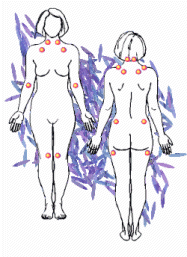|
The Copenhagen official Fibromyalgia Syndrome definition states
that you must have at least 11 out of 18 specified tender points to
be diagnosed with FMS. Tender points hurt where pressed, but do not
refer pain elsewhere -- that is, pressing a tender point does not
cause pain in some other part of the body.(Note that when examining
yourself for tender points, you must use enough pressure to whiten
the thumbnail.)
The official definition further requires that tender points must be present
in all four quadrants of the body -- that is, the upper right and left and lower
right and left parts of your body. Furthermore, you must have had widespread,
more-or-less continuous pain for at least three months. Because tender points
can fluctuate and vary from day to day, if you don't have "11 out of the 18"
on a given day, your doctor may diagnose "possible FMS" and may need
to count the tender points again on future visits.
Tender points occur in pairs on various parts of the body. Because they occur
in pairs, the pain is usually distributed equally on both sides of the body.
On your back, they are present in the following places:
-
along the spine in the neck, where the head and neck meet
on the upper line of the shoulder, a little less than halfway from the
shoulder to the neck
three finger widths, on a diagonal, inward from the last points
- On the back fairly close to the "dimples" above the buttocks, a
little less than halfway in toward the spine
- Below the buttocks , very close to the outside edge of the thigh, about
three finger widths
|
|
On the front of your body, tender points are present in the
following places:
- On the neck, just above inner edge of the collarbone
- Still on the neck, a little further out from the last points, about four
finger widths down
- On the inner (palm) side of the lower arm, about three finger widths below
the elbow crease
- On the inner side of the knee, in the "fat pad"
The tender point locations are not "written in stone." They can
vary from person to person, which can cause further problems with
diagnosis. In traumatic FMS, for example, tender points are often
clustered around an injury instead of, or in addition to, the 18
"official" points. These clusters can also occur around a repetitive
strain or a degenerative and/or inflammatory problem, such as
arthritis.
Index
|

